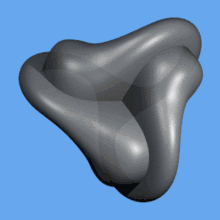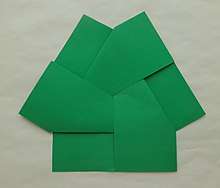Boy's surface
In geometry, Boy's surface is an immersion of the real projective plane in 3-dimensional space found by Werner Boy in 1901. He discovered it on assignment from David Hilbert to prove that the projective plane could not be immersed in 3-space.

Boy's surface is discussed (and illustrated) in Jean-Pierre Petit's Topo the world.[1] Boy's surface was first parametrized explicitly by Bernard Morin in 1978.[2] Another parametrization was discovered by Rob Kusner and Robert Bryant.[3] Boy's surface is one of the two possible immersions of the real projective plane which have only a single triple point.[4]
Unlike the Roman surface and the cross-cap, it has no other singularities than self-intersections (that is, it has no pinch-points).
Construction
To make a Boy's surface:
- Start with a sphere. Remove a cap.
- Attach one end of each of three strips to alternate sixths of the edge left by removing the cap.
- Bend each strip and attach the other end of each strip to the sixth opposite the first end, so that the inside of the sphere at one end is connected to the outside at the other. Make the strips skirt the middle rather than go through it.
- Join the loose edges of the strips. The joins intersect the strips.

Symmetry of the Boy's surface
Boy's surface has 3-fold symmetry. This means that it has an axis of discrete rotational symmetry: any 120° turn about this axis will leave the surface looking exactly the same. The Boy's surface can be cut into three mutually congruent pieces.
Model at Oberwolfach
The Mathematical Research Institute of Oberwolfach has a large model of a Boy's surface outside the entrance, constructed and donated by Mercedes-Benz in January 1991. This model has 3-fold rotational symmetry and minimizes the Willmore energy of the surface. It consists of steel strips which represent the image of a polar coordinate grid under a parameterization given by Robert Bryant and Rob Kusner. The meridians (rays) become ordinary Möbius strips, i.e. twisted by 180 degrees. All but one of the strips corresponding to circles of latitude (radial circles around the origin) are untwisted, while the one corresponding to the boundary of the unit circle is a Möbius strip twisted by three times 180 degrees — as is the emblem of the institute (Mathematisches Forschungsinstitut Oberwolfach 2011).
Applications
Boy's surface can be used in sphere eversion, as a half-way model. A half-way model is an immersion of the sphere with the property that a rotation interchanges inside and outside, and so can be employed to evert (turn inside-out) a sphere. Boy's (the case p = 3) and Morin's (the case p = 2) surfaces begin a sequence of half-way models with higher symmetry first proposed by George Francis, indexed by the even integers 2p (for p odd, these immersions can be factored through a projective plane). Kusner's parametrization yields all these.
Parametrization of Boy's surface
Boy's surface can be parametrized in several ways. One parametrization, discovered by Rob Kusner and Robert Bryant,[5] is the following: given a complex number w whose magnitude is less than or equal to one (), let
so that
where x, y, and z are the desired Cartesian coordinates of a point on the Boy's surface.
If one performs an inversion of this parametrization centered on the triple point, one obtains a complete minimal surface with three ends (that's how this parametrization was discovered naturally). This implies that the Bryant–Kusner parametrization of Boy's surfaces is "optimal" in the sense that it is the "least bent" immersion of a projective plane into three-space.
Property of Bryant–Kusner parametrization
If w is replaced by the negative reciprocal of its complex conjugate, then the functions g1, g2, and g3 of w are left unchanged.
By replacing w in terms of its real and imaginary parts w = s + it, and expanding resulting parameterization, one may obtain a parameterization of Boy's surface in terms of rational functions of s and t. This shows that Boy's surface is not only an algebraic surface, but even a rational surface. The remark of the preceding paragraph shows that the generic fiber of this parameterization consists of two points (that is that almost every point of Boy's surface may be obtained by two parameters values).
Relating the Boy's surface to the real projective plane
Let be the Bryant–Kusner parametrization of Boy's surface. Then
This explains the condition on the parameter: if then However, things are slightly more complicated for In this case, one has This means that, if the point of the Boy's surface is obtained from two parameter values: In other words, the Boy's surface has been parametrized by a disk such that pairs of diametrically opposite points on the perimeter of the disk are equivalent. This shows that the Boy's surface is the image of the real projective plane, RP2 by a smooth map. That is, the parametrization of the Boy's surface is an immersion of the real projective plane into the Euclidean space.
References
Citations
- Petit, J.-P (1985). Topo the World (PDF). Savoir Sans Frontières.
- Morin, Bernard (13 November 1978). "Équations du retournement de la sphère" [Équations of the eversion of the two-sphere] (PDF). Comptes Rendus de l'Académie des Sciences. Série A (in French). 287: 879–882.
- Kusner, Rob (1987). "Conformal geometry and complete minimal surfaces" (PDF). Bulletin of the American Mathematical Society. New Series. 17 (2): 291–295. doi:10.1090/S0273-0979-1987-15564-9..
- Goodman, Sue; Marek Kossowski (2009). "Immersions of the projective plane with one triple point". Differential Geometry and Its Applications. 27 (4): 527–542. doi:10.1016/j.difgeo.2009.01.011. ISSN 0926-2245.
- Raymond O'Neil Wells (1988). "Surfaces in conformal geometry (Robert Bryant)". The Mathematical Heritage of Hermann Weyl (May 12–16, 1987, Duke University, Durham, North Carolina). Proc. Sympos. Pure Math. 48. American Mathematical Soc. pp. 227–240. doi:10.1090/pspum/048/974338. ISBN 978-0-8218-1482-6.
Sources
- Kirby, Rob (November 2007), "What is Boy's surface?" (PDF), Notices of the AMS, 54 (10): 1306–1307 This describes a piecewise linear model of Boy's surface.
- Casselman, Bill (November 2007), "Collapsing Boy's Umbrellas" (PDF), Notices of the AMS, 54 (10): 1356 Article on the cover illustration that accompanies the Rob Kirby article.
- Mathematisches Forschungsinstitut Oberwolfach (2011), The Boy surface at Oberwolfach (PDF).
- Sanderson, B. Boy's will be Boy's, (undated, 2006 or earlier).
- Weisstein, Eric W. "Boy's Surface". MathWorld.
External links
| Wikimedia Commons has media related to Boy's surface. |
- A page dedicated to Boy's surface, containing various visualizations, various equations, and useful links and references
- A planar unfolding of the Boy's surface – applet from Plus Magazine.
- Boy's surface resources, including the original article, and an embedding of a topologist in the Oberwolfach Boy's surface.
- A LEGO Boy's surface
- A paper model of Boy's surface – pattern and instructions
- Java-based model that can be freely rotated
- Line field coloring using Boy's surface
- A model of Boy's surface in Constructive Solid Geometry together with assembling instructions
- Boy's surface visualization video from the Mathematical Institute of the Serbian Academy of the Arts and Sciences